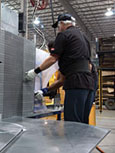
In early 2004 the question was: Would the government mandate 13 SEER? In 2005 the question was: How would the industry prepare for the Jan. 23, 2006 13 SEER deadline? Each individual section of the industry faced multiple challenges.
"The change to 13 SEER is sweeping," said Dale Green, vice president of Trane's marketing and sales. Shipping had to be adjusted, production lines retooled, products redesigned, and people informed that 13 SEER would profoundly impact everyone involved, including the end user.
Manufacturers were at the top of the change list. Many of the products coming from the lines needed to be adjusted or redesigned to meet the new standards. In spite of the challenges, most manufacturers were optimisticly reassuring the industry that there would be enough supply.
"We've been planning on making a major design change around the new SEER levels since about the 2000 time frame, and it's been a process of studying what are the best core technologies and the migrations to get there," said Halsey Cook, president of Carrier's Residential Division.
"We're well focused on the 13 SEER challenge and making sure that we have a product line commensurate with being the industry leader."
Many manufacturers didn't encourage stockpiling of 12 SEER and under units, but most all of them promised to fill orders for such units until Jan. 23.

Distributors spent time expanding warehouse space and making trucking changes. Most of their time, however, was spent on education this past year. The question wrestled with by distributors around the nation: Should we stockpile 12 SEER and under models?
"Some distributors seem reluctant to start getting more 13 SEER into their inventories," said Joe Brandt of Nordyne. "However, they're backing off their 10 SEER inventory."
Other distributors have jumped in with both feet. "Three of my dealers are trying to sell nothing but 14 SEER and up, and they have done well with it," said Gary Moody, vice president of Koldaire Supply Inc., Dallas.

Contractors welcomed the education. They've worked all year to understand and implement the new configurations, sizing, and pricing. Coil matches and marketing were hot topics of discussion as warranties and ethics came into question. Logistically contractors faced sizing issues along with the manufacturers and distributors, not only trucking and storage space, but also install space. Contractors were responsible for educating builders and the end user while instructing their own staff on proper selling techniques and installs.
"The most important thing is to ensure that the indoor and outdoor sections are designed to work together," said Steve Hancock of Trane.
Publication date: 12/26/2005
